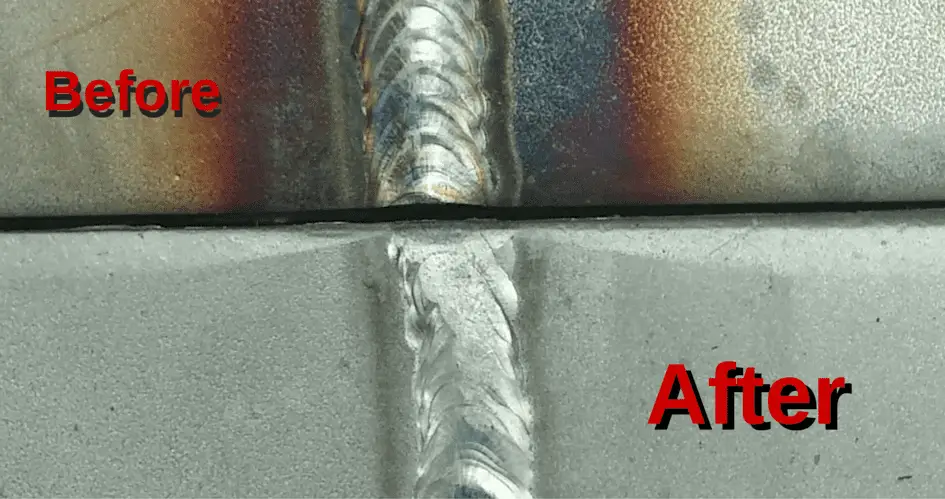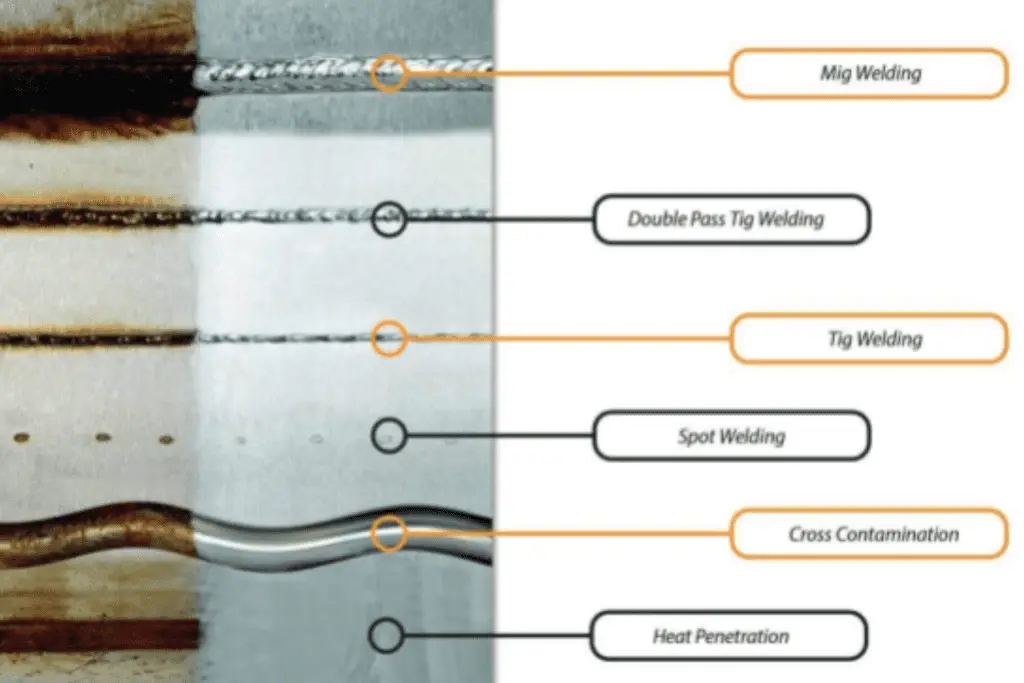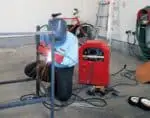If you are a welder enthusiast who often works with stainless steel then I am sure you are aware of the stains which are often produced as a result of the welding process.
These rainbow coloured tints in the surface of steel can not only make your work look less aesthetic but also make your project non-professional.
That is why if you want to keep your stainless steel project look good then it is advisable to do some finishing after you weld.
The best way of removing the weld burns from stainless steel is to do away with the discoloured layer formed as a result of oxidation during the welding process. There are several ways of removing this layer some of which include chemical baths, usage of fluids or pickling pastes, electrochemical finishing and manual grinding.
This article is the compilation of the effective methods present out there to remove these tints from the stainless steel to give you a clean result. Let’s explore them.
Why does stainless steel discolour?
We all have read basic science and know that most metals including stainless steel consist of an oxide layer. This naturally occurring oxide layer thickens when subjected to heat. This thickening is the main reason for discoloration.
The light which is reflected from the oxidised surface is different from the light reflected from the stainless steel surface created by welding.
The variety of colours produced depend on the thickness of the oxide layer. This phenomenon generally occurs around the weld bead and the surrounding zones affected by heat.
Why is it important to remove these stains?
The discoloration of stainless steel which appears after welding is not only a cosmetic issue. There are certain other reasons that demand removal of the tints aka discolouration. First and foremost, it makes your work/project look amateurish and you surely don’t want that.
But we have a greater concern than what I have mentioned above and that is the presence of underlying chromium depleted layer of the alloy. If left untreated, this layer can invite harmful processes such as corrosion and rusting.
Therefore by dealing with this discoloration you are indeed kicking out two major problems. If you want to restore the passive state of your stainless steel then you first have to remove the tempered oxide layer. But how do you do it?
Right and effective ways to remove tints
#1. Using acid bath to remove the welding tint
By soaking the weld joints in nitric acid or hydrofluoric acid, you can easily remove the heat tints from the surface of stainless steel.
These acids are present in large tubes and are easily available at shops which deal with stainless steel on a day to day basis.
Acid baths are budget friendly and are a good solution if you don’t want to spend a hefty amount on cleaning.
However, if you are using the acids, make sure to follow all the safety precautions like wearing all the required protective gears or neutralizing the acid.
What are the advantages of using acid baths?
You can gain the following advantages if you decide to use acid baths.
1.) It only requires one time setup so it’s comparatively inexpensive.
2.) Acid baths are best suited for places where stainless steel is welded regularly.
3.) It requires very little labour.
What are the disadvantages?
There are some disadvantages which can be experienced while using acid baths.
1.) Setup cost is relatively high and is not worth it if you are working only on a few pieces.
2.) The acids which are used in acid baths are quite harsh so you need to be extra careful while dealing with them.
3.) You definitely need to neutralize the acid after soaking the welded piece into it.
5.) Acid baths aren’t suitable for big pieces as they can’t fit into it.
#2. Removing the discolouration after welding using Electrochemical cleaners
Electroplating is the combination of low voltage electricity and weak acid like phosphoric acid. The process consumes electricity by adding a layer of bright metal.
The electrochemical cleaning method takes into account the electric current to separate a layer from the base metal. The method is known to remove all the tinted layers.
This particular method is suitable for small shops or if you are welding at home and want to invest in equipment.
Pros of electrochemical cleaning
√ The process uses phosphoric acid which is much safer than those acids which are used in acid baths.
√ Electrochemical cleaners remove the discolouration evenly without over or under doing it.
√ This method is perfect if you are looking for a mirror finish after welding.
Cons of Electrochemical Cleaning
⊗ As mentioned earlier, it is a bit expensive as it requires a new TIG welder.
⊗ The process is not suitable for places where welding is done in large amounts.
⊗ Sometimes the large parts cannot be dipped in the acid.
#3. Removing the Discolouration by Physically Grinding the Stainless Steel
Another yet very interesting method of removing the stains is by using your angle grinder or belt sander. The grinder basically helps in physically removing the discolored layer.
All you have to do is just keep grinding until you have completely scrapped off the layer which you are supposed to remove.
If you have a tight budget then this could be the best method for you. Moreover, physical grinding is also suitable in cases where the pieces cannot be exposed to indoor railings or counters.
Advantages
√ It doesn’t require additional equipment so is relatively budget friendly.
√ This method is great for large parts or built in equipment.
√ You can control how much layer you want to scrape off.
Disadvantages
⊗ Very tedious and slow process.
⊗ It may or may not give a good finish to seal out corrosion.
⊗ Difficult to be used with small parts.
#4. Getting Rid of the Heat Marks with Blast Cleaning
Sandblasters or other abrasive spray cleaners help in removing the tints as effectively as physical grinding. Using sand, glass beads or walnut shells for removing the unwanted layers can really be a good idea.
If you are already equipped with blast cleaning materials then this method could be a real deal. If you are into painting work and all, sandblasting is really an effective way.
Advantages
√ It is faster than grinding.
√ The method is efficacious if you want to reach tight corners.
√ It is safer than the chemical methods.
Disadvantages
⊗ If you don’t have the equipments then this method can burn a hole in your pocket.
⊗ Compared to grinding, blast cleaning doesn’t always produce passive finish for repelling corrosion.
#5. Applying Pickling Paste to Remove Weld Heat Marks from Stainless Steel
Pickling paste might sound like something new to you. It is a paste prepared using hydrofluoric acid along with nitric acid and some thickening agents. It comes in a thick gel-like consistency and is brushed or sprayed on the tinted area of stainless steel.
You just have to brush the paste on the desired area and leave it for a couple of hours and then rinse away. The process is similar to that of an acid bath except that you don’t really have to dip the pieces into the bath.
The method is suitable for occasional use or small shops that don’t want to spend much. Or you can use it if you are welding stainless steel once every six months or so.
Pros:
√ It is one of the least expensive options and it doesn’t really require any special armamentarium.
√ It is best for occasional use.
√ Requires less labour than grinding.
Cons:
⊗ The paste is made using harmful acids which are highly corrosive and can lead to burns.
⊗ While applying, it might stick and burn if it comes in contact with anything.
⊗ The paste produces a foul smell which is required to be vented.
Final Thoughts
We all know that working with stainless steel isn’t easy at all because of its hardness and resistance to corrosion.
Not just this, if you want your project to look good then you have to put some more effort post welding.
It might look daunting but trust me, any of the above mentioned ways can finish off the task if you figure out how to do it properly. So, plan a project which involves stainless steel and get to work!









